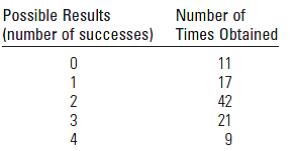

Now, why is it that I get the same answer by seeing this problem as 5 Bernoulli trials each with a probability of success equal to 1/6 and by calculating the desired probability via the binomial distribution, namely the probability of 5 successes out of 5 trials: Where P is the probability of the i t h dice being a 6 Say I have 5 dices in front of me, the probability of 5 of them being a 6 is equal to: The probability of getting a 6 when rolling a dice is 1/6. Thus, the probability of exactly 24 successes is 0.0605. Open an EXCEL sheet and select the cell A1.Įnter the formula =NORM.DIST(24.5,20,4,TRUE)-NORM.DIST(23.5,20,4,TRUE) in the cell A1.
#A binomial distribution has 100 trials software
Step-by-step procedure to obtain probability value using the EXCEL software is given below: Thus, the binomial probability to a normal probability by using continuity correction is P 23. 5 for any number c.īy using continuity correction, the value 0.5 is added to 24 and subtracted from 24. If the binomial probability represents “exactly c” then the normal probability is P c - 0. The binomial probability is converted to a normal distribution probability by using the continuity correction. Thus, the normal distribution can be used to approximate the binomial distribution.

Thus, the requirement n q = 80 ≥ 5 is satisfied.

Either use SALT, or look at a binomial probability distribution table showing binomial probabilities for various values of p, the probability of success on a single trial. Substitute 100 for n and 0.20 for p in the n 1 - p. Consider a binomial distribution with 12 trials. Thus, the requirement n p = 20 ≥ 5 is satisfied. Substitute 100 for n and 0.20 for p in the np. The requirements to check whether the normal distribution can be used to approximate the binomial distribution are: Where p is the probability of success and n is the number of trials.ī. The formula for mean in binomial distribution is, 20 and n = 100.Īssume that x is a binomial random variable with p = 0. The binomial probability distribution has p = 0.


 0 kommentar(er)
0 kommentar(er)
